GALÁPAGOS WEATHER - WHEN TO GO
Although the Galápagos is home to a plethora of wildlife, it has two main seasons: the cool and dry season from June to December, and the warm and rainy season from January to May. The weather remains relatively temperate throughout both seasons, making it a great destination year-round.
The "peak season" for tourism typically falls from mid-December to mid-January, and from mid-June to September. However, due to travel restrictions by the Galápagos National Park Service, you won’t encounter large crowds, allowing you to enjoy the islands' natural serenity in relative solitude.
GALÁPAGOS DRY SEASON
The dry season in Galápagos, also known as the garúa season, is when temperatures cool down. As cold waters travel north from Antarctica, the climate becomes more subtropical than tropical.
One of the most noticeable effects of the subtropical climate is the misty drizzle that coats the island peaks, turning the vegetation lush and green. Since garúa translates to "drizzle" in English, this is a fitting name for the misty season.
The garúa season attracts more marine mammals, fish, and birds due to the Humboldt Current bringing nutrient-rich waters to the area. Although the drizzle affects the highlands, the lowlands remain arid, offering plenty of wildlife opportunities in both regions.
The seas are teeming with fish, making it an excellent time to observe seabirds and Galápagos penguins diving for food.
GALÁPAGOS RAINY SEASON
The rainy season extends from January to May, with the warmest waters and air temperatures of the year. During this period, the tropical rain showers are heaviest from January through March, although the storms are typically brief.
The predominately sunny days and warm waters, which flow from Colombia and Panama, make for great snorkeling conditions. While the clearest weather and calmest waters occur between March and April, the fish populations peak later in the year as cooler waters bring greater marine diversity.
WILDLIFE NEVER HIBERNATES IN THE GALÁPAGOS
The Galápagos Islands are teeming with wildlife. While each season offers different experiences, there’s always something remarkable to see. Whether you want to witness animals nesting, hatching, mating, or migrating, our Galápagos Unbound SignatureTour and our offers extraordinary wildlife encounters year-round. The wildlife never hibernates, so your adventure needn’t either.
See below for a breakdown of monthly weather and wildlife events and check out our Galapagos weather and wildlife info-graphic for a helpful visual!
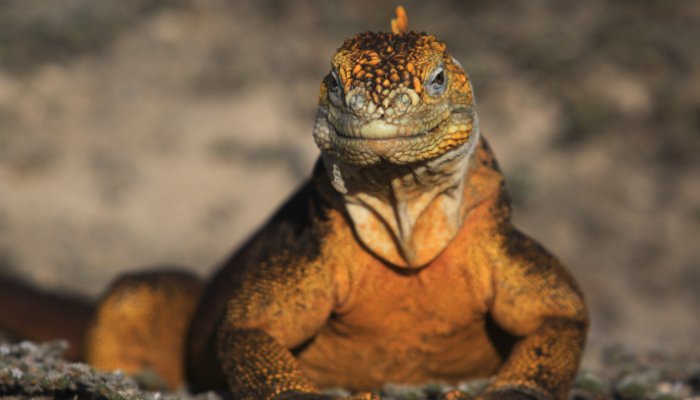
JANUARY
January in the Galápagos is customarily sunny with occasional rainfall in the afternoon. Temperatures are rising throughout the islands, and with temperatures in the 80s and the ocean balmy and in the 70s, the Galápagos in January is no winter wonderland.
Weather Snapshot
- Air Temp (Max / Min): 30/22C, 86/72F
- Hours of clear skies: 5.3
- Average Rainfall: 2.5cm, 1.0in (in the highlands)
- Average Water Temperature: 24.5C / 76F
Wildlife Activity
- Giant tortoise eggs are beginning to hatch! Watch for baby tortoises scampering about
- Galápagos green turtles come to shore to lay their eggs
- Male marine iguanas develop bright coloring to attract future mates on Española Island
- Land birds begin to nest after the first rain of the season
- Land iguanas begin mating rituals on Isabela Island
Hike, paddle, and snorkel in the tropical paradise that is Galápagos on our Galápagos & Mainland Ecuador Multisport Tour.
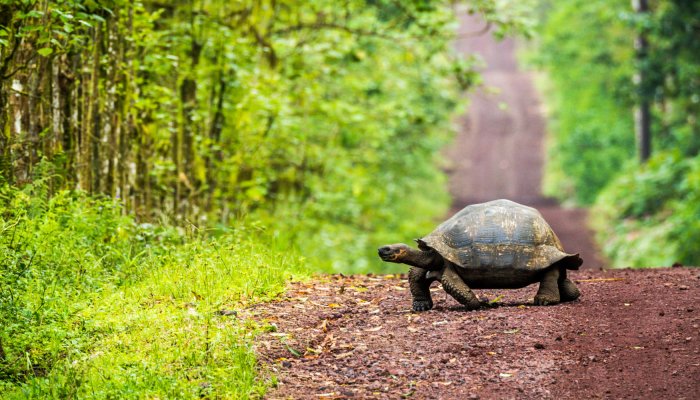
FEBRUARY
Things keep warming up from January to February, though the sunny days and afternoon showers continue.
Weather Snapshot
- Air Temp (Max / Min): 30 / 24C, 86 / 75F
- Hours of clear skies: 7.5
- Average Rainfall: 2.5cm, 1.0in (in the highlands)
- Average Water Temperature: 25C / 77F
Wildlife Activity
- Giant tortoise eggs continue to hatch throughout the islands
- Galápagos penguins can be seen on Bartolomé Island before they commence migration to Fernandina and Isabela Island for cooler waters.
- Marine iguanas begin to nest on Santa Cruz Island
- Greater flamingos start nesting on Floreana Island
- The Galápagos dove’s nesting season reaches its height
- Nazca boobies end their nesting season on Española island
Take a look at the giant tortoises that had Darwin so fascinated on our Galápagos Islands Luxury Adventure Cruise.
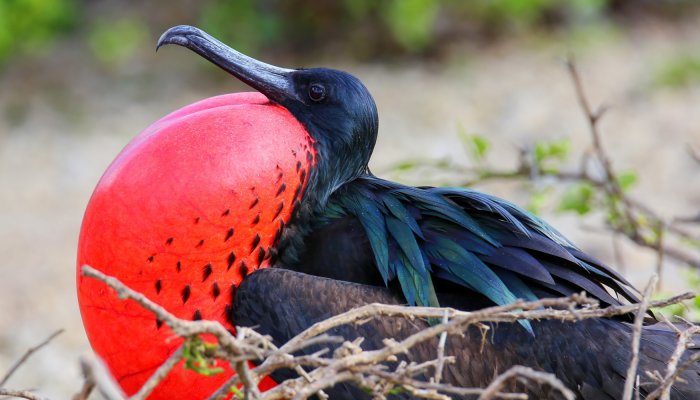
MARCH
March brings in the rainiest season of the Galápagos; an average of two inches of precipitation fall within the month.
Weather Snapshot
- Air Temp (Max / Min): 31 / 24C, 88 / 75F
- Hours of clear skies: 6.0
- Average Rainfall: 5.1cm, 2.0in (in the highlands)
- Average Water Temperature: 25C / 77F
Wildlife Activity
- Galápagos penguins can be seen on Isabela Island
- Frigatebirds begin to inflate their bright red throat pouches on Genovesa and San Cristóbal Islands in hopes of attracting mates
- The waves albatross begins to arrive on the shores of Española Island after the summer equinox
- Giant tortoise eggs continue to hatch
- Marine iguanas can be seen nesting on Seymour and Fernandina Islands
See Galápagos in its rainy season glory from the comfort of a cabin on the Eric or Letty yacht, specifically designed for cruising the Galápagos Islands.
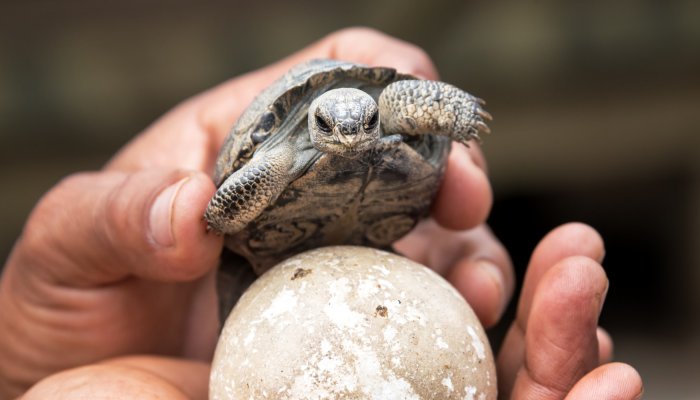
APRIL
Things to begin to cool a bit in April. April showers continue throughout the month, although the average rainfall drops from the previous month.
Weather Snapshot
- Air Temp (Max / Min): 31 / 24C, 88 / 75F
- Hours of clear skies: 7.5
- Average Rainfall: 3.8cm, 1.5in (in the highlands)
- Average Water Temperature: 25C / 77F
Wildlife Activity
- Galápagos green turtle eggs start to hatch along the beaches
- Land iguana eggs begin to hatch on Isabela Island
- Waves albatross begin to flock to Española Island in droves
- Waves albatross begin their courtship rituals
- Giant tortoise hatching season comes to an end
Kayak through the waters of Galápagos and see all its accompanying wildlife on a Galápagos, Otavalo & Amazon Trip.
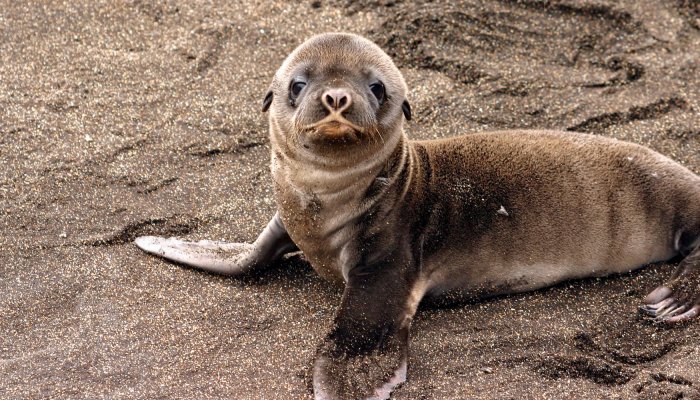
MAY
Air and water temperatures continue to cool and the tropical rain showers begin to wane.
Weather Snapshot
- Air Temp (Max / Min): 28 / 22C, 82 / 72F
- Hours of clear skies: 5.2
- Average Rainfall: 1.9cm, 0.75in (in the highlands)
- Average Water Temperature: 24.5C / 76F
Wildlife Activity
- Galápagos green sea turtles continue hatching in Punta Cormorant on Floreana, Puerto Egas on Santiago, and in Gardner Bay on Española
- Galápagos sea lions mate from May through January, and their pups are born a year after conception. In May, you can come across mating sea lions or some new sea lion pups greeting the world
- Marine iguana eggs begin hatching rom nests on Santa Cruz Island
- Waved albatross begin laying eggs on Española Island
- Blue-footed boobies begin mating dance on Seymour Island
- Band-rumped storm petrels start their initial nesting period
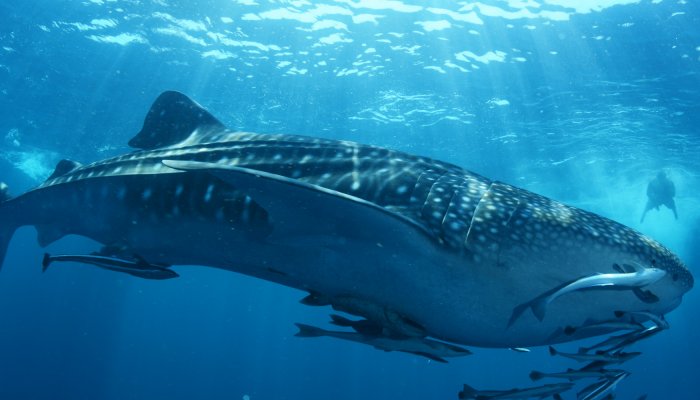
JUNE
Tropical rain showers become infrequent as water and air temperatures continue to drop.
Weather Snapshot
- Air Temp (Max / Min): 26 / 21C, 79 / 70F
- Hours of clear skies: 4.4
- Average Rainfall: 0.6cm, 0.25in (in the highlands)
- Average Water Temperature: 23C / 73F
Wildlife Activity
- Giant tortoises begin to migrate to the lowland in search for nesting sites on Santa Cruz
- Pods of whales may be seen passing Galápagos as they migrate to the Equator along Ecuador’s coast from June to September.
- Whale sharks can be seen off the coasts of the northwestern islands towards the end of June
- Short-eared owls begin to mate on Genovesa
- Male frigatebirds and their red throat pouches can be spotted throughout Seymour
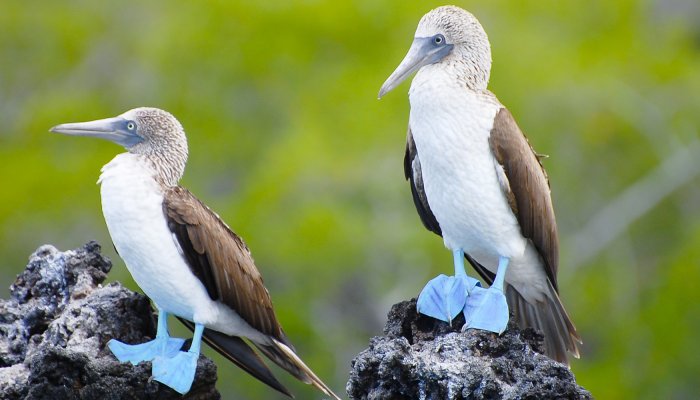
JULY
July brings in the garúa, or dry, season. Air temperatures continue to cool into the 60s while water temperatures drop to the low 70s. Rain shows continue to be infrequent.
Weather Snapshot
- Air Temp (Max / Min): 26 / 20C, 79 / 68F
- Hours of clear skies: 2.8
- Average Rainfall: 1.3cm, 0.50in (in the highlands)
- Average Water Temperature: 22C / 72F
Wildlife Activity
- Whale sharks can be seen off the coasts of Wolf and Darwin Islands
- Dolphin and whale sightings increase; Isabela’s western coast is one of the best spots
- Frigatebird chicks begin to hatch
- Greater flamingoes begin to mating “dances” to court potential mates
- Lava lizards begin their mating season which continues through November
- Flightless cormorants begin to court and nest on Fernandina Island
- Blue-footed boobies become active on Española and bobby eggs, chicks, juveniles, and young adults can be seen throughout the island
- Oystercatchers begin to nest on Santiago Island
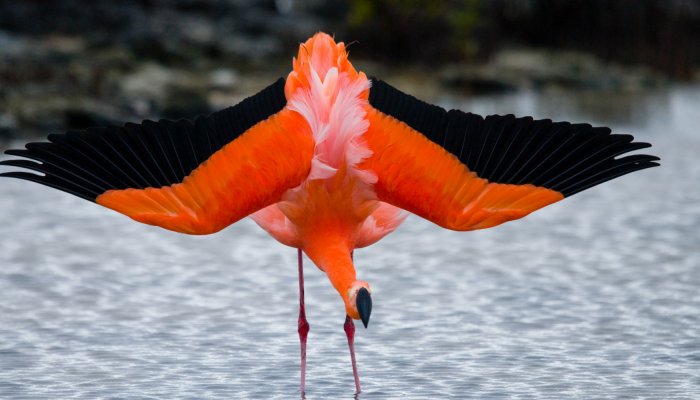
AUGUST
The Galápagos Islands are at their coolest in August with highs reaching the mid-70s. Water temperatures drop below 70, their lowest temperatures throughout the year. The dry season continues.
Weather Snapshot
- Air Temp (Max / Min): 26 / 19C, 79 / 66F
- Hours of clear skies: 3.3
- Average Rainfall: 0.6cm, 0.25in (in the highlands)
- Average Water Temperature: 21.5C / 71F
Wildlife Activity
- Giant tortoises begin the return migration to the Santa Cruz highlands following nesting
- Galápagos sea lions continue to give birth to their pups, with the largest populations on the central and western islands.
- Greater flamingos continue their courtship dance
- Frigatebird chicks begin hatching
- Galápagos hawks begin courtship rituals on Santiago and Española Islands
- Nazca boobies and swallow-tailed gulls begin to nest on Genovesa
- Migratory shorebirds begin their stopover on Galápagos Islands through March
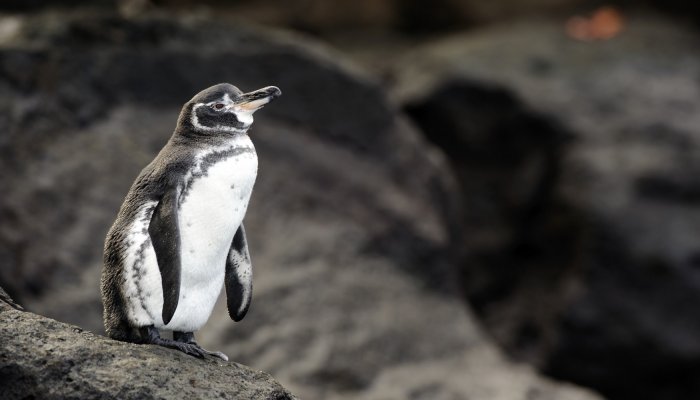
SEPTEMBER
The garúa season reaches its prime during September, and the terrestrial animals and birds grow more active.
Weather Snapshot
- Air Temp (Max / Min): 26 / 19C, 79 / 66F
- Hours of clear skies: 2.9
- Average Rainfall: 1.3cm, 0.50in (in the highlands)
- Average Water Temperature: 22C / 72F
Wildlife Activity
- Sea lions active along the shores
- Seabirds lively at nesting sites
- Galápagos penguins begin courtship on Bartolomé Island—a mating ritual that continues through December
- Migrating whale sharks and humpback whales can be seen off the coasts of the northwestern islands
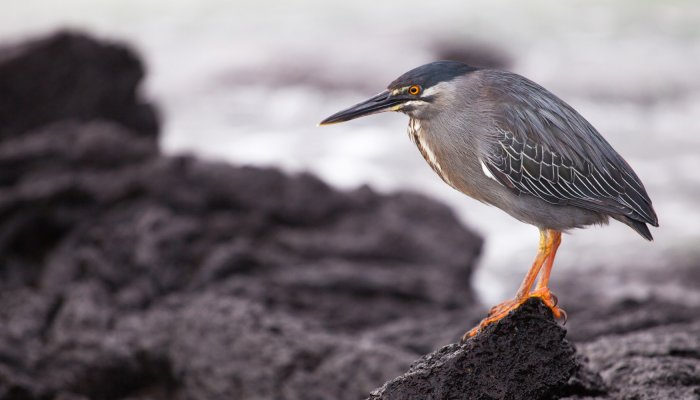
OCTOBER
Although the garúa season carries on, the Galápagos begins to warm with water temperatures returning to the low 70s. Coastal regions experience occasional haze while higher peaks have clear weather.
Weather Snapshot
- Air Temp (Max / Min): 26 / 20C, 79 / 68F
- Hours of clear skies: 3.8
- Average Rainfall: 0.6cm, 0.25in (in the highlands)
- Average Water Temperature: 22.5C / 73F
Wildlife Activity
- Whale sharks remain nearby Wolf and Darwin Islands
- Galápagos fur seals commence their mating season
- Blue-footed booby chicks being to mature on Española and Isabela Islands
- Lava herons begin nesting, which continues through March
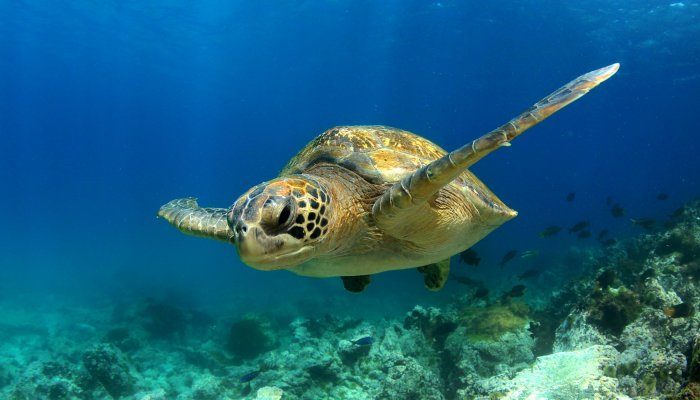
NOVEMBER
The Galápagos continues to warm up. Conditions for snorkeling begin to improve as the surrounding seas are calm and visibility increases as the haze lessens.
Weather Snapshot
- Air Temp (Max / Min): 26 / 21C, 79 / 70F
- Hours of clear skies: 3.5
- Average Rainfall: 1.3cm, 0.50in (in the highlands)
- Average Water Temperature: 23C / 73F
Wildlife Activity
- Galápagos green sea turtles are at their prime in their mating season, and their activities are at their best for human observation from November through January
- Galápagos sea lion pups continue to be born. At this point, sea lion mothers begin to relax and the older pups are allowed to play with human guests
- Brown noddy mating season begins
- Band-rumped storm petrels commence their secondary nesting period
Explore Galápagos tropical water during prime conditions on our Dive Galápagos tour.
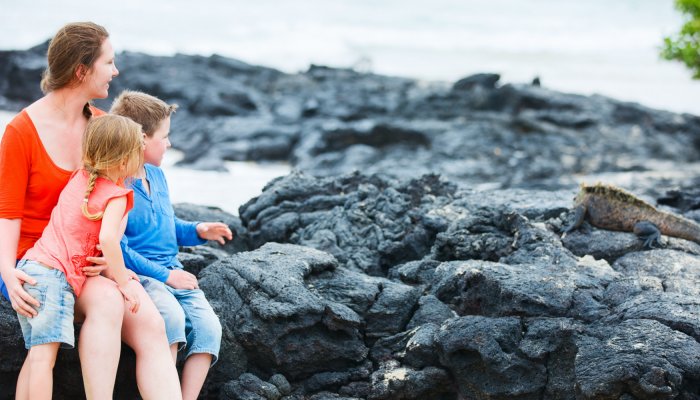
DECEMBER
The garúa season concludes. Although tropical rain showers remain infrequent, the Galápagos Island plants begin to turn green. Temperatures rise with highs in the low 80s and a low of 70. Water temperatures on average stay in the mid-70s.
Weather Snapshot
- Air Temp (Max / Min): 27 / 22C, 81 / 72F
- Hours of clear skies: 4.0
- Average Rainfall: 1.3cm, 0.50in (in the highlands)
- Average Water Temperature: 22.5C / 73F
Wildlife Activity
- Giant tortoise egg hatching begins in December and continues through April
- Galápagos green turtles continue their mating season
- Waved albatross chicks develop their wings for flight, allowing them to leave the islands until their return migration in March
Experience all that December in the Galápagos has to offer on a Galápagos Islands: Christmas Vacation.

